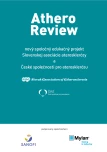Statin-associated myopathy: clinical guideline of Slovak Atherosclerosis Association and Czech Society for Atherosclerosis
Authors:
Daniel Pella; Anna Gvozdjáková; Ján Lietava; Jana Tisoňová; Katarína Rašlová; Branislav Vohnout (za Slovenskou Asociaci Aterosklerózy); Michal Vrablík; Vladimír Bláha; Renata Cífková; Richard Češka; Tomáš Freiberger; Pavel Kraml; Jan Piťha; Hana Rosolová; Vladimír Soška; Tomáš Štulc; Hana Vaverková; Zuzana Urbanová (za Českou Společnost Pro Aterosklerózu)
Published in:
AtheroRev 2016; 1(1): 7-13
Category:
Guidelines
*(za Slovenskou asociaci aterosklerózy)
**(za Českou společnost pro aterosklerózu)
Overview
Side effects of lipid lowering drugs have gained much attention. In general, statin intolerance is defined as muscle or other adverse effects (or laboratory abnormalities) associated with statin treatment, which lead to its discontinuation or make the dose titration (and, thus, attaining LDL-cholesterol goals) impossible. The frequency of statin intolerance varies between 1% and 20% in different groups reported. The most important category is statin associated myopathy (SAM). As there is no laboratory marker of SAM with sufficient sensitivity and specificity, it is recommended to use a score system to assess the probability of SAM based on symptoms´ characteristics. There are many risk factors of the development of SAM (including drug interactions) that should be evaluated (and eliminated, if possible) before the initiation of statin treatment. From the treatment point of view, it is necessary to mention most patients with SAM are able to tolerate another statin/alternative dosing of a statin. In case of absolute intolerance (e.g. intolerance of at least 2 or 3 different statins) non-statin lipid lowering drugs should be considered. Novel therapeutic options (PCSK9 inhibitors) seem to be very promising in this respect.
Key words:
alternative therapy – lipid lowering drugs – score system – side effects – statins – statin associated myopathy – statin intolerance
Sources
1. Pasternak RC, Smith SC Jr, Bairey-Merz CN et al. American College of Cardiology. American Heart Association. National Heart, Lung and Blood Institute. ACC/AHA/NHLBI Clinical advisory on the use and safety of statins. Circulation 2002; 106(8):1024–1028.
2. Rosenson RS, Baker SK, JacobsonTA et al. An assessment by the statin muscle safety task force: 2014 update. J Clin Lipidol 2014; 8(3 Suppl): S58–S71.
3. Stroes ES, Thompson PD, Corsini A et al. European Atherosclerosis Society Consensus Panel. Statin-associated muscle symptoms: impact on statin therapy-European Atherosclerosis Society Consensus Panel Statement on Assessment, Aetiology and Management. Eur Heart J 2015; 36(17):1012–1022.
4. Finegold JA, Manisty CH, Goldacre B et al. What proportion of symptomatic side effects in patients taking statins are genuinely caused by the drug? Systematic review of randomized placebo-controlled trials to aid individual patient choice. Eur J Prev Cardiol 2014; 21(4):464–474.
5. Parker BA, Capizzi JA, Grimaldi AS et al. Effect of statins on skeletal muscle function. Circulation 2013; 127(1):96–103.
6. Bruckert E, Hayem G, Dejager S et al. Mild to moderate muscular symptoms with high-dosage statin therapy in hyperlipidemic patients--the PRIMO study. Cardiovasc Drugs Ther 2005; 19(6):403–414.
7. Buettner C, Rippberger MJ, Smith JK et al. Statin use and musculoskeletal pain among adults with and without arthritis. Am J Med 2012; 125(2):176–182.
8. Graham DJ, Staffa JA, Shatin D et al. Incidence of hospitalized rhabdomyolysis in patients treated with lipid-lowering drugs. JAMA 2004; 292(21): 2585–2590.
9. Guyton JR. Benefit versus Risk in Statin Treatment. Am J Cardiol 2006; 97(8A): 95C-97C.
10. Banach M, Rizzo M, Toth PP et al. Statin intolerance- an attempt at a unified definition. Position paper from an Internanational Lipid Expert Panel. Expert Opin Drug Saf 2015; 14(6): 935–955.
11. Khayznikov M, Hemachrandra K, Pandit R et al. Statin Intolerance Because of Myalgia, Myositis, Myopathy, or Myonecrosis Can in Most Cases be Safely Resolved by Vitamin D Supplementation. N Am J Med Sci 2015; 7(3):86–93.
Labels
Angiology Diabetology Internal medicine Cardiology General practitioner for adultsArticle was published in
Athero Review

2016 Issue 1
Most read in this issue
- Familial hypercholesterolemia: clinical reports, molecular genetics and differential diagnosis
- PCSK9 inhibitors in the management of patients with high cardiovascular risk – effective treatment to reach
- Turn in hypercholesterolemia treatment – PCSK9 inhibitors. What we know about the alirocumab (product Praluent®) yet?
- Statin-associated myopathy: clinical guideline of Slovak Atherosclerosis Association and Czech Society for Atherosclerosis
